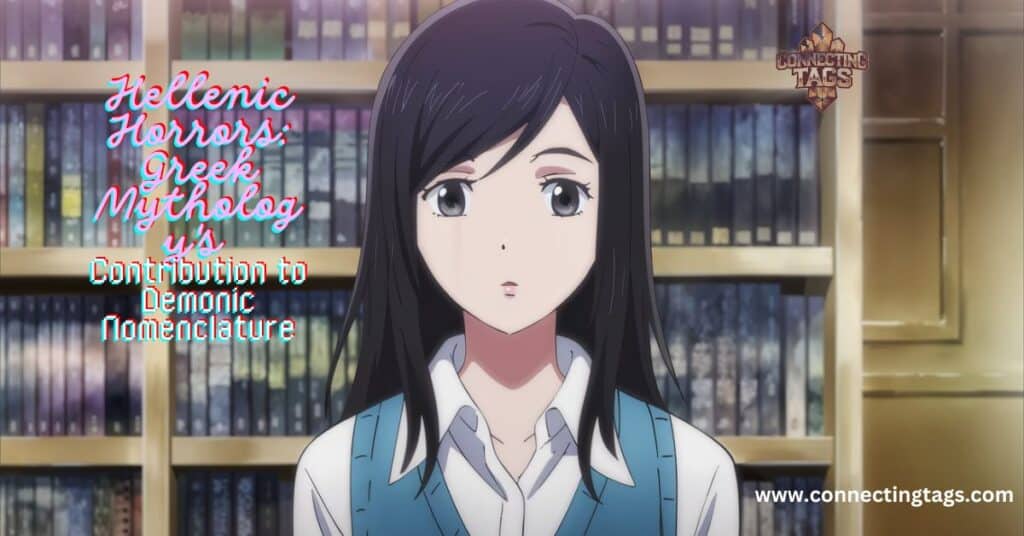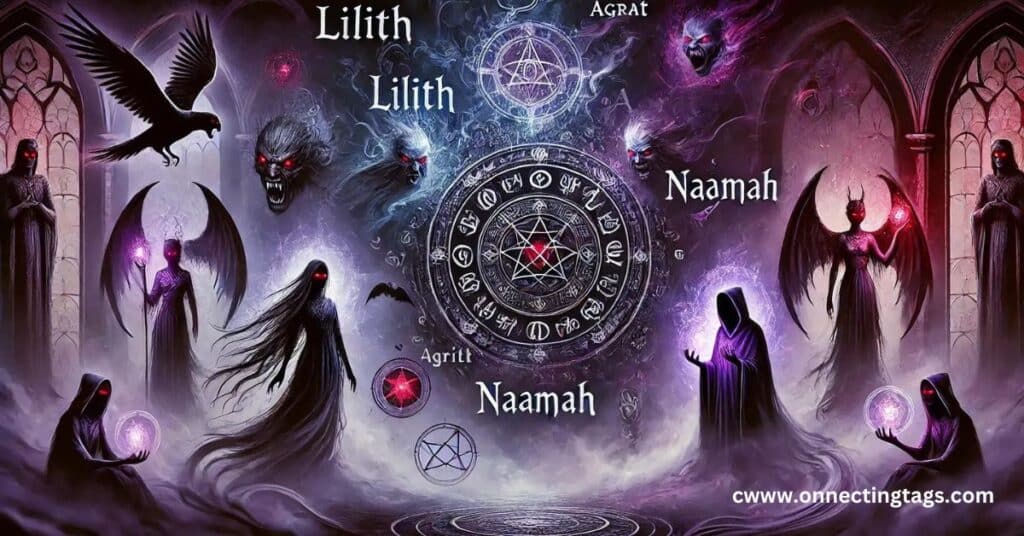Fearless adventurers and thrill-seekers! Ready to embark on a spellbinding journey into the shadowy realm of powerful female demons? First, come to jump headfirst into a world where mystery, danger, and dark enchantment reign supreme. 👿
Popular Names for Female Demons are legendary and spellbinding journeys that have echoed through ancient lore and, more recently, captured the fascination of modern pop culture. From seductive sirens to vengeful spirits, these dark queens’ names will, without a doubt, send chills down your spine. 🌑
Consequently, you will uncover the most popular names for female demons that will have you, at last, questioning the fine line between darkness and light so, are you ready to embrace the unknown? 🌘
Why Do Female Demons Captivate Our Imagination?
A Spellbinding Journey
Ever wonder why we are so drawn to the bad girls of the supernatural world? It is not just about the fangs and the flames, folks. Female demons tap into something primal in our psyche, challenging our notions of good and evil, power and vulnerability.
Think about it. In a world where women are often expected to be nurturing and gentle, female demons flip the script. They’re powerful, dangerous, and unapologetically themselves. It’s like they’re giving a big, fiery middle finger to societal norms.
But here is the kicker:
Our fascination with these dark ladies is not just about rebellion. It’s about complexity. Female demons embody the parts of ourselves we often hide away the anger, the desire, the hunger for power. They’re the ultimate antiheroes, walking the line between terrifying and terrifyingly relatable.

Quote:
“To me, the thing that is worse than death is betrayal. You see, I could conceive death, but I could not conceive betrayal.” – Malcolm X
This quote might as well be the motto of many female demons. They have been betrayed, cast out, or misunderstood, and now they are out for revenge. And let’s be honest, who hasn’t felt like unleashing a little hellfire after being wronged?
From Ancient Lore to Modern Pop Culture | Female Demon Names
Alright, history buffs, let’s take a trip down memory lane. Female demons have been around since humans first started telling stories around the campfire.
In ancient times, female demons were often used to explain the unexplainable. Childbirth complications? Must be Lamashtu. Nightmares? Probably Lilith up to her old tricks. These names carried weight, evoking fear and respect in equal measure.
Fast forward to today, and our demon ladies have gotten a bit of a makeover. Thanks to movies, TV shows, and books, female demons are more complex than ever. Now, they have backstories, motivations, and sometimes even a soft spot for us mere mortals.
Take Maze from the TV show “Lucifer,” for example. She is a demon, sure, but she’s also fiercely loyal, struggles with human emotions, and rocks a mean leather jacket.
Here is a quick rundown of how female demon portrayals have evolved:
- Ancient times: Fearsome entities to be avoided at all costs
- Middle Ages: Temptresses leading good folks astray
- Victorian era: Symbolic of repressed desires and fears
- Modern day: Complex characters with their own goals and motivations
The names have evolved too. We’ve gone from the ancient Sumerian “Lamashtu” to the catchy modern “Hellfire Hailey” (okay, I made that one up, but admit it, it’s got a ring to it!).
Ancient Mesopotamian Demonesses
Whispers from the Abyss
Now, let’s get down to brass tacks and talk names. We are kicking it old school with some Mesopotamian mamas who were striking fear into hearts before writing was even a thing.
Lilith | The Original Rebel Without a Cause Female Demon Names
First up, the OG bad girl herself: Lilith. This name has staying power, folks. In Jewish folklore, Lilith was Adam’s first wife who refused to play second fiddle. She said “See ya!” to Paradise and became the mother of demons. Talk about a career change!
Lilith’s name has become synonymous with female empowerment and rebellion. She is the patron saint or should we say demon? of women who refuse to be submissive. In modern usage, you might see Lilith as:
- A feminist icon
- A symbol of attraction
- The name of your goth neighbor’s black cat
Pazuzu | The Queen of Wind Demons
Next up, we’ve got Pazuzu. Don’t let the funny name fool you this lady was bad news. As the queen of wind demons, she was blamed for all sorts of nasty stuff like famine and locusts.
Pazuzu’s name might ring a bell for horror movie fans. Yep, she is the demon that possessed poor Regan in “The Exorcist.” Talk about a lasting legacy! These days, Pazuzu is often associated with:
- Chaos and destruction
- Protective amulets (ironically, her image was used to ward off evil)
- Really intense weather phenomena
Lamashtu | The Baby Snatcher Supreme
Last but definitely not least in our Mesopotamian lineup, we’ve got Lamashtu. If you thought your mother in law was bad, get a load of this gal. Lamashtu was known for snatching and eating babies, causing miscarriages, and generally making life miserable for mothers and children.
Lamashtu’s name still carries weight in discussions about:
- Fears surrounding childbirth and infant mortality
- The darker aspects of motherhood
- Ancient beliefs about women’s health and reproduction
These Mesopotamian mamas set the stage for all the demonesses that would follow. They embody primal fears and societal anxieties, wrapped up in names that have echoed through the millennia.
Greek Mythology’s Contribution to Demonic Nomenclature
Hellenic Horrors
Alright, let’s hop across the Mediterranean and check out what the ancient Greeks were cooking up in terms of female demons. Spoiler alert: they were just as terrifying, with a dash of tragic backstory for good measure.
Empusa | The OG Shape-Shifting Seductress
First up, we have got Empusa. This lady was the original catfish, centuries before online dating was a thing. Empusa could change her form to lure in unsuspecting men, then feast on their blood and flesh. Talk about a bad Tinder date!
Empusa’s name is still used today to describe:
- Deceptive people (especially in romantic contexts)
- The fear of being tricked or manipulated
- Creatures that can change their form at will
Mormo | The Ancient Greek Vampire Female Demon Names
Before Edward and Bella were even a twinkle in Stephenie Meyer’s eye, there was Mormo. This Greek demoness was said to bite bad children and drink their blood. Parents probably used her name to scare kids into behaving. “Eat your vegetables, or Mormo will get you!”
Today, Mormo’s name pops up in:
- Discussions about early vampire lore
- Debates about using fear as a parenting tactic
- Some pretty awesome metal band names
Keres | The Original “Grim Reapers” | Female Demon Names
Last in our Greek lineup, but certainly not least, we have got the Keres. These were not your garden variety demons. Nope, these sisters were the spirits of violent death. Think of them as the Grim Reaper’s meaner, more proactive cousins.
The Keres have left their mark on:
- Depictions of death in art and literature
- Discussions about fate and destiny
- Our understanding of how ancient cultures viewed violent death
Greek mythology gave us some of the most enduring and complex female demon names. These ladies were not just evil for evil’s sake they had motivations, backstories, and sometimes even a twisted sense of justice.

Eastern Enigmas | Female Demons in Asian Folklore
Alright, globe-trotters, let’s head east and check out some of the spine chilling female demons that have been keeping Asia up at night for centuries. Trust me, these ladies make your average horror movie villain look like a cuddly teddy bear.
Yuki-onna | Japan’s Deadly Snow Woman
First up, we have got Yuki-onna, the “Snow Woman” of Japanese folklore. Picture this: you are lost in a blizzard, and suddenly you see a beautiful woman in a white kimono. Sounds like a rescue, right? Wrong! Yuki-onna is more likely to freeze you solid than help you find your way home.
Yuki-onna’s name is still chilling spines in:
- Japanese horror movies and anime
- Discussions about the dangerous beauty of nature
- Wintertime ghost stories around the world
Rakshasi | Hindu Mythology’s Shape-Shifting Demonesses
Next, let’s talk about the Rakshasi. In Hindu mythology, these ladies were the female counterparts to the male Rakshasa demons. But let’s be real, they were way scarier. Rakshasi could change their form at will, often appearing as beautiful women to lure in unsuspecting victims.
The Rakshasi have left their mark on:
- Indian literature and cinema
- Discussions about feminine power in mythology
- Modern fantasy stories featuring shape-shifters
Gui Po | China’s Hungry Ghost Grandma
Last but not least in our Asian tour, we’ve got Gui Po from Chinese folklore. Imagine a ghostly old woman with a hunger for human souls, and you’ve got Gui Po. She is often depicted with long, white hair and a terrifying grin. Not exactly the kind of grandma you want baking you cookies!
Gui Po’s influence can be seen in:
- Chinese ghost stories and horror films
- Traditions surrounding the Hungry Ghost Festival
- Modern urban legends about vengeful spirits
These Asian demonesses show us that the fear of powerful, supernatural women is truly universal. From the snowy mountains of Japan to the bustling cities of India and China, these names have been whispered in fear for generations.
Fae and Fiends from the Misty Isles Names for Female Demons
Celtic Cunningness
Alright, let’s hop across the pond and dive into the misty world of Celtic mythology. These Irish and Scottish ladies might seem a bit more subtle than their Eastern counterparts, but trust me, they’re just as capable of ruining your day (or your life).
Banshee | The Wailing Harbinger of Death
First up, we have got the Banshee. You know that feeling when you hear a weird noise at night and your heart starts racing? Yeah, imagine that, but the noise is a blood-curdling scream that means someone’s about to die. That is the Banshee for you.
The Banshee’s name still echoes in:
- Irish and Scottish folklore
- Modern horror stories and films
- Really loud and annoying car alarms (okay, maybe that’s just me)
Morrigan | The Phantom Queen of Battle
Next, let’s talk about the Morrigan. This lady was not just a demon, she was a straight-up goddess of war, fate, and death. She’d show up on battlefields in the form of a crow, deciding who lived and who died. Talk about a power trip!
The Morrigan’s influence can be seen in:
- Modern pagan and Wiccan practices
- Fantasy literature and games
- Discussions about female warrior figures in mythology
Dearg Due | Ireland’s Bloodthirsty Bride
Last in our Celtic lineup, we have got Dearg Due. Her name means “Red Blood Sucker” in Irish, which pretty much tells you all you need to know. Legend has it she was a beautiful woman forced into a bad marriage, who came back from the grave to take her revenge.
Dearg Due’s tale resonates in:
- Vampire lore from around the world
- Stories about women taking revenge on abusive partners
- Irish horror films and literature
These Celtic female demons show us a different side of darkness. They’re not just evil for the sake of it; they’re complex figures tied deeply to the land, to fate, and to the cycle of life and death. Their names carry the weight of ancient traditions and the mist-shrouded landscapes they come from.

Demonesses from Judeo-Christian Traditions
Biblical Baddies
Alright, time to get biblical! You might think the good book is all about angels and saints, but let me tell you, it’s got some seriously scary ladies lurking in its pages. These Judeo-Christian demonesses have been giving Sunday school teachers nightmares for centuries.
Jezebel | The Painted Lady of Corruption
First up, we’ve got Jezebel. In the Bible, she was a wicked queen who led people astray. But over time, her name has become shorthand for any woman seen as overly seductive or morally corrupt. Talk about a PR nightmare!
Jezebel’s name is still stirring up trouble in:
- Discussions about women’s sexuality and societal expectations
- Political rhetoric (calling someone a “Jezebel” is still a thing)
- Explorations of female villains in literature and film
Naamah | The Seductive Fallen Angel Names for Female Demons
Next on our list is Naamah. According to some traditions, she was a fallen angel who became a demon of prostitution. But get this: her name actually means “pleasant” or “beautiful.” Talk about irony!
Naamah’s influence can be seen in:
- Debates about the nature of temptation and sin
- Artistic depictions of fallen angels
- Discussions about the demonization of female attraction
Agrat bat Mahlat | Queen of the Demons of Prostitution
Last but not least, we’ve got Agrat bat Mahlat. With a title like “Queen of the Demons of Prostitution,” you know she means business. In some traditions, she is one of Lilith’s daughters and rules over a quarter of hell. Talk about a family business!
Agrat bat Mahlat’s name comes up in:
- Studies of ancient Hebrew demonology
- Discussions about the stigmatization of attraction
- Modern occult practices and demonology
These biblical baddies show us how religious traditions have shaped our ideas about female power and attraction. Their names carry the weight of centuries of moral debates and societal fears.
Pop Culture Princesses of Darkness | Modern Interpretations
Alright, pop culture junkies, this one’s for you! Let’s fast forward to the present day and check out how female demons are taking over our screens, pages, and playlists. These modern demonesses are proof that bad girls have all the fun (and the best character arcs).
Maze from “Lucifer” | The female demon names with a Heart
First up, we’ve got Mazikeen, better known as Maze, from the TV show “Lucifer.” This demon turned bounty hunter is proof that even hellspawn can have a killer fashion sense and some serious character development.
Maze has become an icon for:
- Complex female antiheroes
- Discussions about loyalty and found family
- Really awesome Halloween costume ideas
Sabrina Spellman | The Teenage Witch Turned Queen of Hell
Next, let’s talk about Sabrina Spellman from “Chilling Adventures of Sabrina.” This is not your ’90s sitcom witch. Nope, this Sabrina signs the Dark Lord’s book and eventually becomes the Queen of Hell herself. Talk about a glow-up!
Sabrina’s journey resonates with:
- Explorations of female power and agency
- Coming-of-age stories with a dark twist
- Debates about morality and the nature of good and evil
Maleficent | Disney’s Misunderstood Dark Fairy
Last but certainly not least, we have got Maleficent. Originally the villain of “Sleeping Beauty,” recent retellings have transformed her into a complex antihero with a tragic backstory. She is proof that even the scariest demons might have a softer side.
Maleficent’s evolution has influenced:
- Reexaminations of classic fairy tales
- Discussions about the nature of villainy and redemption
- Some seriously epic cosplay
These modern demonesses show us how far we have come in our portrayal of female villains. They are no longer just cackling evildoers, they are complex characters with depth, motivations, and often a wicked sense of humor.
Crafting Your Own Demonic female Moniker
The Power of Naming
Alright, aspiring dark lords and ladies, listen up! Creating a demonic name is not just about slapping together some scary sounding syllables. It is an art form, a delicate balance of terror and intrigue. Whether you are writing the next big fantasy novel or just looking to spice up your D&D character, here is how to craft a demonic name that will make even Lucifer do a double take.

FAQs
Delving Deeper into the World of Female Demons.
Q: What’s the difference between a goddess and a female demon?
A: The line between goddesses and female demons is often blurry and culturally dependent. Generally, goddesses are worshipped and seen as beneficial (though not always benevolent), while demons are feared and associated with malevolence. However, many figures (like Kali or Hecate) have been viewed as both goddesses and demons in different contexts.
Q: Are there any “good” female demons in mythology?
A: While demons are typically portrayed as malevolent, some mythologies feature more ambiguous or even helpful demonic figures. For example, in some interpretations of Zoroastrian mythology, the demon Jahi is seen as a protector of women.
Q: How do female demon names differ across cultures?
A: Female demon names often reflect the linguistic and cultural contexts they come from:
- Semitic languages (Hebrew, Arabic): Often feature guttural sounds (Lilith, Naamah)
- Greek/Roman: Tend to end in -a or -e (Lamia, Mormo)
- Norse: May incorporate nature elements (Hel)
- Eastern cultures: Often more melodic, with repeated syllables (Rangda, Hariti)
Q: Can demons change their names or have multiple names?
A: In many traditions, demons are believed to have multiple names or titles. Some occult practices suggest that knowing a demon’s “true name” gives power over it. In fiction, demons often use different names when interacting with humans or disguising their nature.
Q: What role do popular female demons play in modern occult practices?
A: In some modern occult and neo-pagan practices, female demons (or demonized goddesses) are invoked as symbols of empowerment, rebellion against patriarchal norms, or sources of hidden knowledge.
the end
As we conclude our spellbinding journey through the dark and mysterious world of female demon names, you undoubtedly gain a newfound appreciation for the depth and complexity of these powerful figures. Moreover, ancient myths and modern interpretations alike consistently captivate us with the power and femininity embodied by female demons. In addition, their stories reveal a profound connection between strength and rebellion that challenges traditional narratives.
Not only do iconic female demon names evoke fear, but they also spark intrigue, prompting us to rethink what true empowerment means. Furthermore, these captivating figures, with their timeless names, reverberate through history and deeply resonate in our cultural imagination. Specifically, they remind us of the enthralling balance between darkness and light, which continues to make them endlessly fascinating. Likewise, these names reflect the enduring allure of mysterious and rebellious femininity.
Ultimately, you can embrace the power, mystique, and history behind these legendary names as they challenge perceptions and provoke thought. Consequently, the legacy of these female demons persists across generations, inspiring both fear and fascination. Therefore, as their influence transcends time, they remain vital symbols of power and mystery.

I am Mery Qam. I am an experienced and professional blogger at Connecting Tags. With a passion for discovering the latest and most creative names or tags. I provide insightful and engaging content. My expertise is in curating fresh and unique names, tags, and titles across various niches, making a trusted source for name ideas that are both trendy and timeless.







